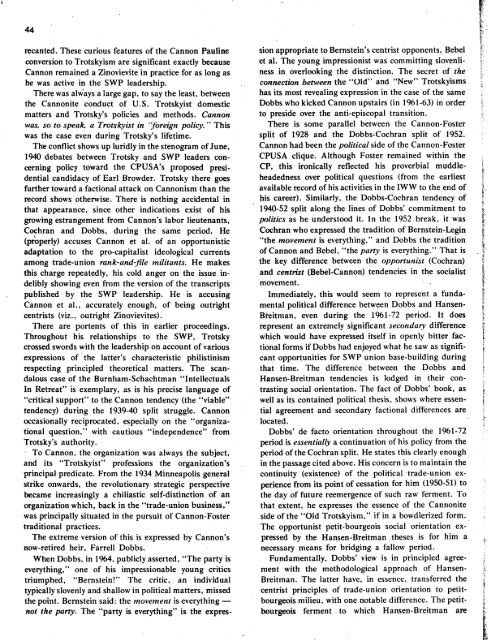S LIBERAL HELPERS
S LIBERAL HELPERS
S LIBERAL HELPERS
- No tags were found...
Create successful ePaper yourself
Turn your PDF publications into a flip-book with our unique Google optimized e-Paper software.
_triumphed, "Bernstein!" The critic, an individual Breitman. The latter have, in essence, transferred thetypically slovenly and shallow in political matters, missed centrist principles of trade-union orientation to petitthepoint. Bernstein said: the movement is everything _ bourgeois milieu, with one notable difference. The petitnotthe party. The "party is everything" is the expres- bourgeois ferment to which Hansen-Breitman are [_[!__44 i _¸recanted. These curious features of the Cannon Pauline sion appropriate to Bernstein's centrist Opponents, Bebelconversion to Trotskyism are significant exactly because et al. The young impressionist was committing slovenli- !Cannon remained a Zinovievite in practice for as long as ness in overlooking the distinction. The secret of the ihe was active in the' SWP leadership, connection between the "Old" and "New" Trotskyisms _There was al_ays a large gap, to say the least, between has its most revealing expression in the case of the samethe Cannonite conduct of U.S. Trotskyist domestic Dobbs whokicked Cannon upstairs (in 1961-63) in ordermatters and Trotsky's policies and methods. Cannon to preside over the anti-episcopal transition. _was, so to speak, a Trotskyist in '_fbreign policy. '"This There is some parallel between the Cannon-Fosterwas the case even during Trotsky's lifetime, split of 1928 and the Dobbs-Cochran split of 1952.The conflict shows up luridly in the stenogram of June, Cannon had been the political side of the Cannon-Foster1940 debates between Trotsky and SWP leaders con- CPUSA clique. Although Foster remained within thecerning policy toward the CPUSA's proposed presi- CP, this ironically reflected his proverbial muddledentialcandidacy of Earl Browder. Trotsky there goes headedness over political questions (from the earliestfurther toward a factional attack on Cannonism than the available record of his activities in the IWW to the end of _.record shows otherwise. There is nothing accidental in his career). Similarly, the Dobbs-Cochran tendency of ithat appearance, since other indications exist of his 1940-52 split along the lines of Dobbs' commitment togrowing estrangement from Cannon's labor lieutenants, politics as he understood it. In the 1952 break, it was !Cochran and Dobbs, during the same period. He Cochran who expressed the tradition of Bernstein-Legin i:(properly) accuses Cannon et al. of an opportunistic "the movement is everything, and Dobbs the tradition _iadaptation to the pro-capitalist ideological currents of Cannon and Bebel, "the party is everything." That is _among trade-union rank-and-file militants. He makes the key difference between the opportunist (Cochran)this charge repeatedly, his cold anger on the issue_ in- and centr_t (BebeI-Cannon) tendencies in the socialist [delibly showing even from the version of the transcripts movement. !published by the SWP leadership. He is accusing Immediately, this would seem to represent a funda-Cannon et al., accurately enough, of being outright mental political difference between Dobbs and Hansencentrists(viz., outright Zinovievites). Bfeitman, even during the 1961-72 period. It does !_There are portents of this in earlier proceedings, represent an extremely significant seconda_ difference fThroughout his relationships to the SWP, Trotsky which would have expressed itself in openly bitter fac- icrossed swords with the leadership on account of various tional forms if Dobbs had enjoyed what he saw as signifiexpressionsof the latter's characteristic philistinism cant opportunities for SWP union base-building duringrespecting principled theoretical matters. The scan- that time. The difference between the Dobbs anddalous case of the Burnham-Schachtman "Intellectuals Hansen-Breitman tendencies is lodged in their con-In Retreat" is exemplary, as is his precise language of trasting social orientation. The fact of Dobbs' book, as ii:"critical support" to the Cannon tendency (the "viable" well as its contained political thesis, shows where essen- i:tendency) during the 1939-40 split struggle. Cannon tial agreement and secondary factional differences are ioccasionally reciprocated, especially on the "organiza- located.tional question," with cautious "independence" from Dobbs' de facto orientation throughout the 1961-72 :Trotsky's authority, period is essentially a continuation of his policy from theTo Cannon, the organization was always the subject, period of the Cochran split. He states this clearly enoughand its "Trotskyist" professions the organization's in the passage cited above. His concern is to maintain theprincipal predicate. From the 1934 Minneapolis general continuity (existence) of the political trade-union exstrikeonwards, the revolutionary strategic perspective perience from its point of cessation for him (1950-51) tobecame increasingly a chiliastic self-distinction of an the day of future reemergence of such raw ferment. Toorganization which, back in the "trade-union business," that extent, he expresses the essence of the Cannonitewas principally situated in the pursuit of Cannon-Foster side of the "Old Trotskyism," if in a bowdlerized form.traditional practices. The opportunist petit-bourgeois social orientation ex-The extreme version of this is expressed by Cannon's pressed by the Hansen-Breitman _theses is for him a _now-retired heir, Farrell Dobbs. necessary means for bridging a fallow period.iwhen Dobbs, in 1964, publicly asserted, "The party is Fundamentally, Dobbs' view is in principled agree- ieverything," one of his impressionable young critics ment with the methodological approach of Hansen- _

















